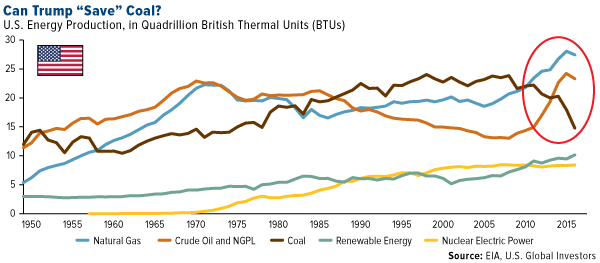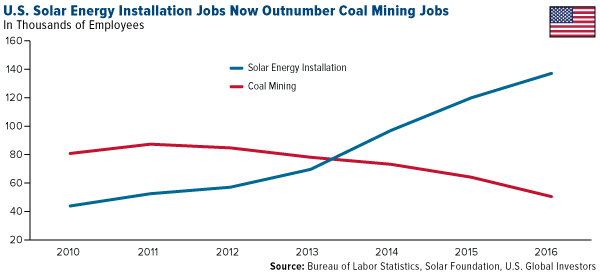Take a look at the 114-year history of the coal industry in West Virginia, the second-largest U.S. coal producer after Wyoming. Since shortly after World War II, the number of coal mining jobs has steadily decreased. In 2014, the state industry employed a little over 18,000 people, a far cry from the 125,000 it employed in 1948.
Interestingly, though, annual production levels since 1948 have remained within a 100-million-ton range. This suggests that, like fracking, better and more efficient mining tools and methods have offset the need for so many workers. More is done with less. It’s safe to say we can’t wholly blame regulations for the decline in coal jobs.
Growing Demand in Renewables
Also working against coal is the rising demand in renewable energy, specifically solar. This is reflected in the growing number of jobs in solar energy installation, to say nothing of solar manufacturing, project development, and sales and distribution. In 2016, more than 137,000 people were employed in solar installation in the U.S., compared to a little over 50,000 people in coal nationwide.
According to the Solar Foundation, the industry accounted for one out of every 50 new U.S. jobs in 2016, the fourth consecutive year in which solar employment grew more than 20 percent.
As I’ve written about before, the surge in solar demand is a
Flanked by coal workers, President Donald Trump signed the American Energy Independence Executive Order last week, directing the Environmental Protection Agency (EPA) to review the Clean Power Plan, former President Barack Obama’s signature environmental policy. Unveiled in August 2015, the plan is intended to reduce carbon dioxide emitted from U.S. power plants 32 percent by 2030. Because Trump cannot directly overrule this particular regulation, the EPA must come to a finding on whether it needs to be modified or repealed.
Shares of American coal mining companies jumped in response last Tuesday. Kentucky-based Ramaco Resources closed up more than 13 percent, with impressive gains also made by Cloud Peak Energy and Peabody Energy
As expected, the executive order prompted criticism from environmentalist groups and acclaim from business leaders and workers in the energy sector. Among the media outlets that heaped praise on Trump was the Wall Street Journal’s editorial board, which wrote that the president “deserves credit for ending punitive policies that harmed the economy for no improvement in global CO2 emission or temperatures.”
I believe the editors make a valid point that Obama’s plan accomplished too little at too great expense. However, there are two points on which I might disagree with others
One, part of Trump’s goal here is to make America energy-independent, as the order’s name implies. Free of burdensome regulations, it’s believed, U.S. energy can be unleased, and we can become a net-exporting nation. The truth is that the U.S. has never been so energy-independent as it is now, even in the face of strict Obama-era rules and regulations. In January, the Energy Information Administration (EIA) forecasted that, even with the Clean Power Plan in place, the country would be a net energy exporter by 2026. Trump’s executive order is unlikely to move that target significantly. And remember, thanks to fracking and the recent lifting of a 40-year ban on oil exports, the U.S. is now a net petroleum exporter.
Two, Trump’s efforts are seen as benefiting the coal industry the most, but I think there are greater forces at work than regulations, as restrictive as they’ve become.
Where Have All the Coal Jobs Gone?
To be clear, I don’t think anyone sincerely believes Trump can “save” coal or coal miners’ jobs. We can probably all agree, however, that he’s at least seeking a way for the coal industry to do what it can to compete with other forms of energy, including renewables and fracking. Coal might very well continue to lose share in the U.S. even after regulations are lifted. That’s fair. But it will be the free market making the choice to retire coal, not government officials.
It’s important to recognize that coal faces several challenges that deregulation won’t be able to block. For one, the fracking boom flooded the market with cheap natural gas, compelling many U.S. power plants to make the switch from coal to gas. Thanks to fracking, gas and oil production now outpaces coal production. By 2040, natural gas will account for 40 percent of U.S. …read more
Source:: Frank Talk
The post Can Trump Dig Coal out of Its Slump? appeared first on Junior Mining Analyst.


